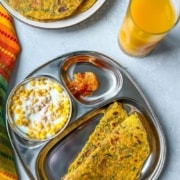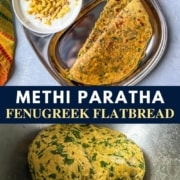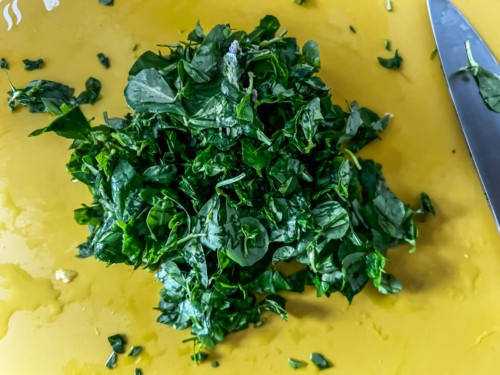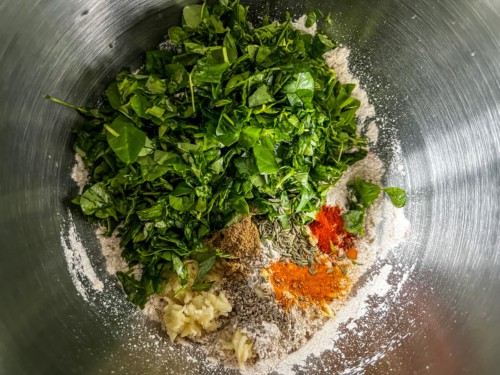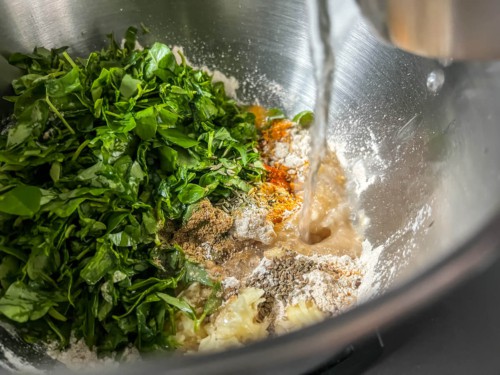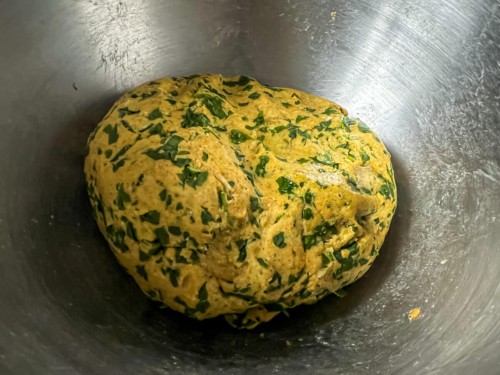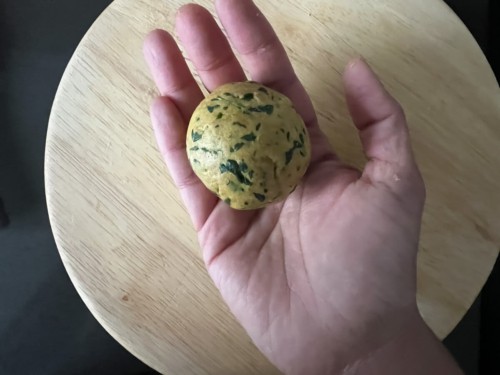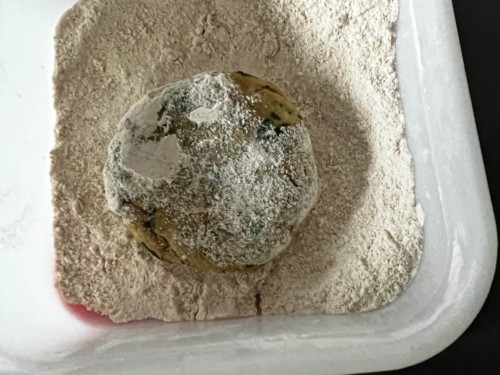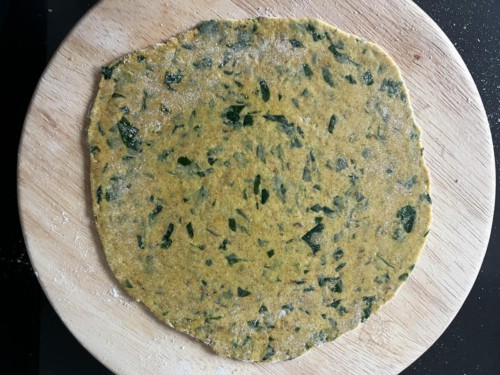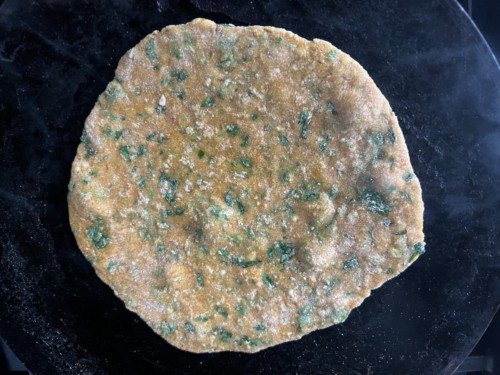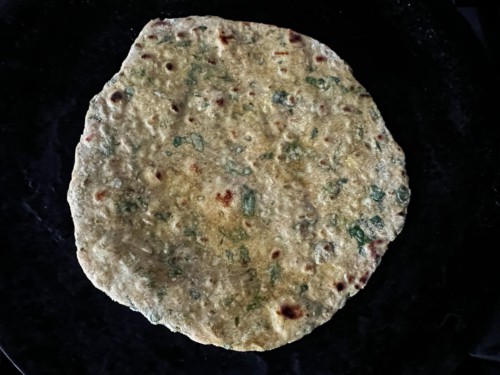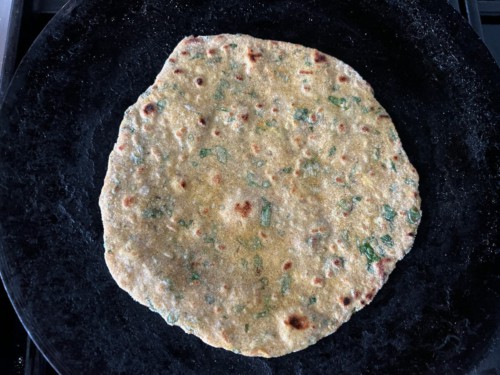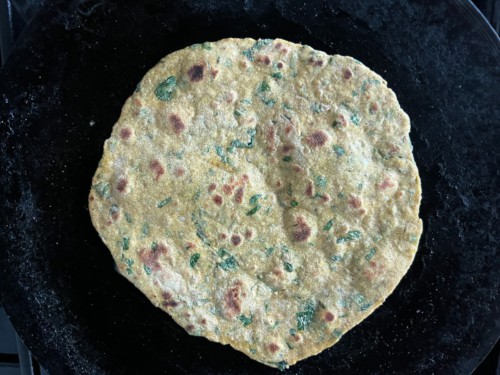Methi Paratha (Fenugreek flatbread)
Note: This post contains affiliate links. As an Amazon Associate I earn from qualifying purchases.
This flavorful methi paratha or methi roti makes the perfect savory breakfast, snack, or lunch accompaniment. The fragrant methi leaves make these healthy parathas a gastronomic experience that you won’t soon forget.
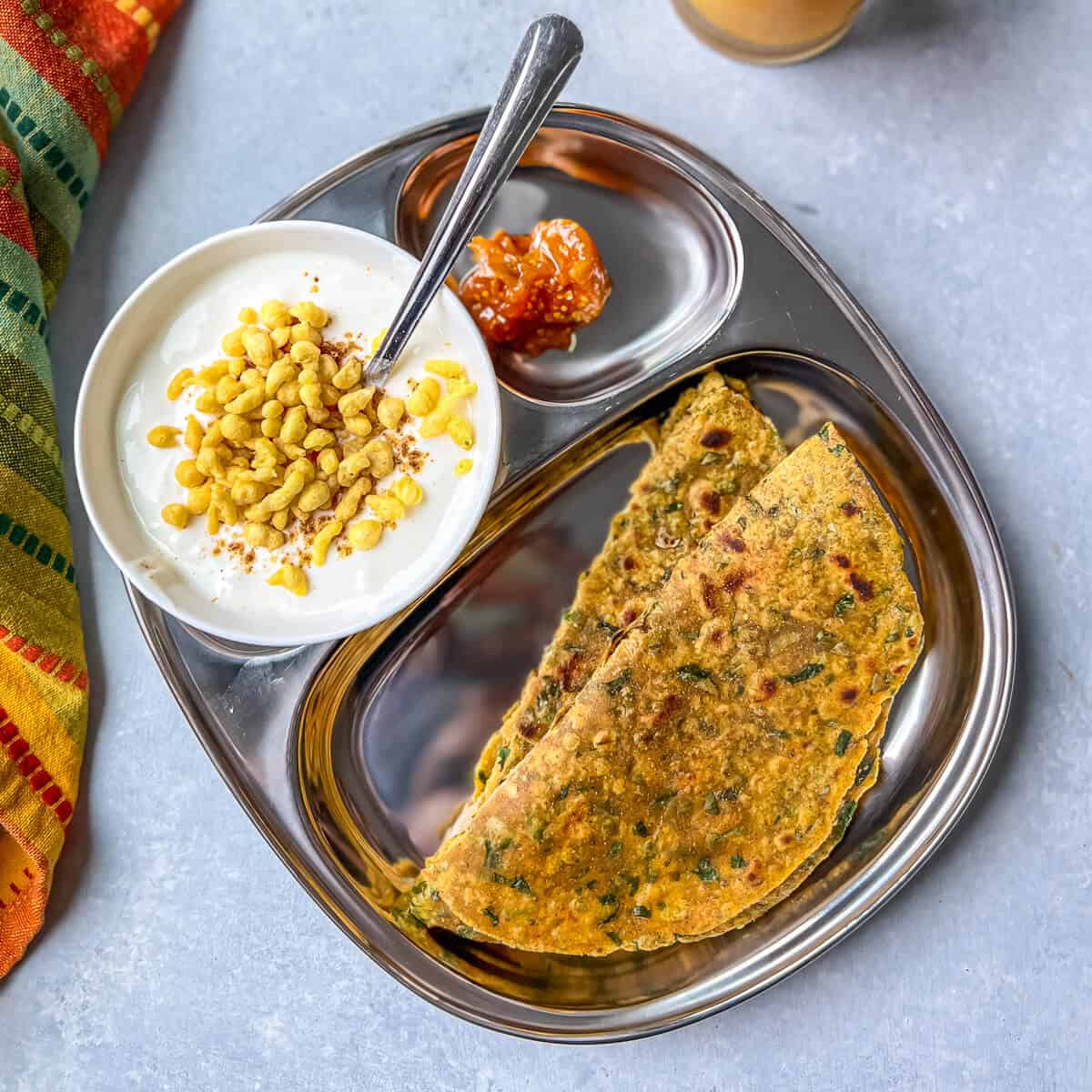
Paratha is a very popular North Indian flatbread that features flaky, ghee-slathered layers and a crispy texture. Growing up in a South Indian family meant I always had my Mother’s homemade idlis in my school lunch, but I would swap my North Indian friends for their parathas if I had the opportunity.
Whether it is the standard plain paratha, or a flavorful and failproof aloo paratha, these flaky Indian flatbreads are one of my favorite things to eat for breakfast, snack time, or even a school or work lunch.
This recipe for methi paratha is a savory, flavorful, and delicious variation that includes freshly chopped methi leaves, garlic, and spices. Serve it with butter and a side of pickle for a simple breakfast or alongside a creamy paneer curry for a complete meal.
What is methi roti / paratha made of?
Methi roti (or methi paratha) is made using a basic plain paratha base, which includes whole wheat flour, water, salt, oil (avocado or vegetable), and melted ghee. In addition to the basic dough, freshly chopped methi leaves, garlic, and spices are added to give a delicious and savory flavor.
Reasons to love this recipe
- These soft Indian flatbreads are made with whole wheat flour, meaning they are a healthy choice for everyday meals.
- Long shelf life – it won’t go bad without refrigeration for 2-3 days, making it perfect for travel.
- Easily adapted to be vegan – swap the ghee for oil.
- Perfect for any time of the day. Enjoy it for breakfast or pack it for lunch, along with raita and/or a cup of piping hot masala tea.
Benefits of fenugreek leaves
Fenugreek (pronounced feh·nyu·greek) leaves have a slightly bitter taste and are similar to fennel or celery leaves in flavor. The Hindi word for fenugreek is methi, and this is what it is referred to in India, where it is commonly used in a variety of dishes.
Fenugreek greens have long been used in traditional medicine, and they contain a host of health benefits. Here are a few of the many benefits that methi has to offer:
- Beneficial for diabetes – The amino acids in fenugreek stimulate insulin secretion and increases insulin sensitivity. This helps to regulate glucose levels.
- It helps control cholesterol by increasing good cholesterol and reducing the release of bad cholesterol.
- Weight management – Fenugreek leaves are high in fiber, which keeps you satiated and helps control cravings.
- High in antioxidants which helps prevent cell damage.
Read more: Benefits of fenugreek leaves
Fenugreek, in addition to its Hindi word methi, is known by a variety of names throughout the world. This includes bird’s foot, Greek clover, alhova, fenogreco, chandrika, woo lu bar, bockshornklee, Greek hay, and many others.
How to clean methi leaves
Fresh fenugreek leaves tend to have mud in the roots. The easiest way to clean them is to remove the roots and pluck the leaves from the stems. Then clean the leaves and rinse them several times until the water runs clear. This will take care of any remaining mud.
Methi paratha vs. methi thepla
If you’re familiar with methi thepla, you may be thinking that this methi paratha recipe sounds very similar and perhaps could even be the same. While it is true that the two are similar, they are different in several ways.
- The key difference is that methi thepla always uses yogurt, while this ingredient is only optional when making methi parathas.
- Paratha is only made with whole wheat flour, whereas thepla is made using besan (Bengal gram flour) or bajra (millet).
- Methi thepla also calls for more ingredients, including sesame seeds, fennel seeds, and ginger.
- The dough for methi paratha is made with water which yields a soft dough, while thepla has a firm dough made with plain curd or yogurt.
Methi paratha or fenugreek paratha recipe is also known by the following names:
- Methi ke paratha
- Methi ka paratha
- Methi chapati
- Punjabi methi paratha
- Kasoori methi paratha
- Methi roti
Here’s what you need to make the recipe
Ingredient notes/swaps
- Chopped fenugreek leaves or methi leaves – I recommend finding fresh methi leaves, but frozen will work too. Remember to account for the excess moisture and reduce the water used in the recipe.
- Whole wheat flour – I prefer either Aashirwad whole wheat atta or Sujata chakki atta.
- Garlic – This compliments the fenugreek flavor perfectly.
- Spices – You will need Kashmiri red chili powder, turmeric powder, carom seeds (ajwain), and dry mango powder (amchur).
- Salt – A small amount of salt is added to the dough to provide flavor.
- Oil – You will need about two tablespoons of oil. I prefer avocado oil, but you can use a neutral-flavored oil of your choice.
- Water– This needs to be at room temperature and will be added to the paratha dough as needed. Remember to reduce the amount if using frozen methi leaves.
For Rolling Out:
- Additional whole wheat flour – To reduce sticking during rolling.
- Ghee – This should be melted and will be brushed on each paratha to create flaky, delicious layers.
Be sure to check out the full recipe and ingredient list below.
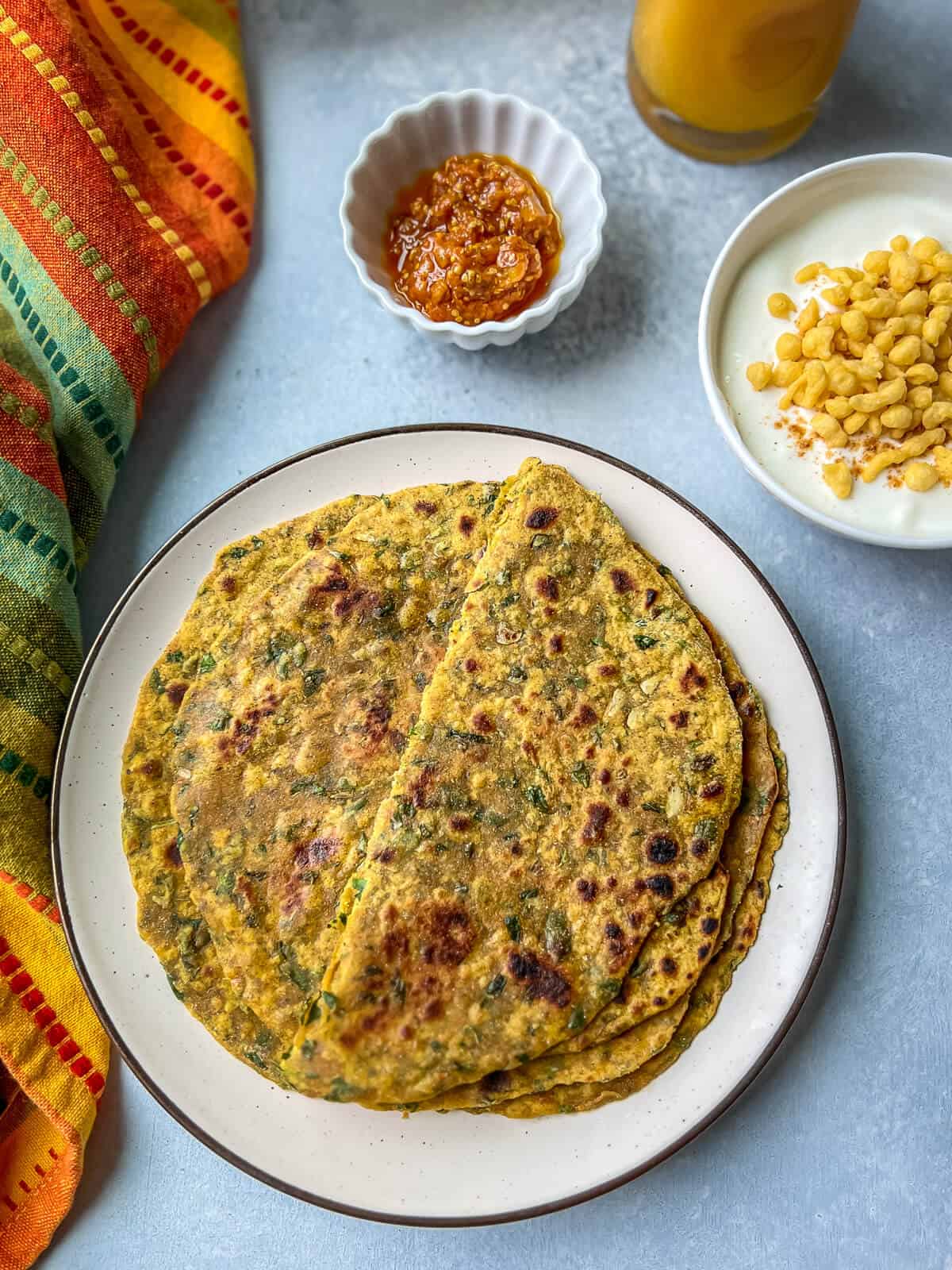
Tools
You’ll need the following equipment to make parathas
- Large mixing bowl or stand mixer / food processor
- Rolling board – Metal/ marble / wood base with a rolling pin (or Chakla Belan in Hindi)
- Tava / Griddle
- Spatula / Turner
- Paper towel
TIPS
General tips while making parathas
- Knead the dough until it is smooth, soft, and pliable.
- To fix hard dough, Sprinkle a spoonful of water and knead. Add more water as needed until the dough is neither hard nor sticky.
- Sticky dough? Sprinkle a spoonful of dough and knead. Add more flour as needed until the dough is not sticky.
- Rest the dough to allow time for the gluten to form. This makes it easier to roll out the dough and yields softer parathas.
- Make sure to dust off the dry flour from the parathas before frying, or it dries up and turns hard.
- Before storing it in an air-tight container or while packing it for lunch, let the paratha cool down for 5-6 minutes to prevent it from being soggy.
Pro tips for methi parathas
- Fresh methi tends to have mud in its roots. Make sure to chop the roots and discard them immediately. Pluck the leaves from the stems. Clean and rinse the leaves a couple of times to get rid of mud residue.
Note: Don’t forget to turn your exhaust fan on when making parathas, or else your smoke alarm may go off.
Serve it with
Like all parathas, this fenugreek version pairs well with raitas, yogurt, or Indian pickle. It also tastes delicious with paneer curries, thanks to the buttery flavor. Here are a few of my favorite dishes to serve with methi paratha:
- Onion raita – Make it with ingredients that you have at home and in less than 5 minutes!
- Mint raita – This refreshing yogurt-based dip made from mint is a worthy accompaniment to delicious biryanis, parathas, and more.
- Boondi raita – Made by soaking crispy chickpea flour balls in spice-infused creamy yogurt. Perfect for serving with biryanis or with parathas and a side dish.
- Cucumber raita – This delicious, cooling Indian raita is made of grated cucumber combined with creamy yogurt, and cilantro and tempered with curry leaves. This yogurt dip is a perfect way to wrap up a spicy Indian meal.

Frequently asked questions
While thepla and methi paratha may seem very similar, there are significant differences that make them very distinct. While methi is made only with whole wheat flour, thepla can be made with besan (Bengal gram flour) or bajra (millet). Parathas also use a much softer dough made with water, while thepla has a firm dough made with yogurt. Methi thepla also calls for more ingredients, such as sesame seeds, ginger, and fennel seeds.
Methi (also known as fenugreek leaves) has a subtle bitterness and a similar taste to that of fennel or celery leaves. Methi leaves are not as bitter as the seed and add a fragrant and fresh flavor to a variety of dishes.
Since methi paratha is made with whole wheat flour, it is more nutrient-dense than other flatbreads, such as naan, which are typically made with refined flour. When paired with raita or paneer curries, it makes a delicious and filling healthy meal.
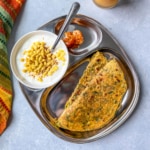
Methi Paratha recipe
Equipment
Ingredients
For the dough
- 2 cup methi leaves, finely chopped
- 3 cups whole wheat flour
- 3-4 garlic cloves, minced
- 1 teaspoon Kashmiri chili powder
- ½ teaspoon turmeric powder
- 1 teaspoon coriander powder
- 1 teaspoon carom seeds (ajwain)
- 1 teaspoon fennel seeds (saunf)
- 1 teaspoon salt
- 2 tablespoons oil (avocado or vegetable) + 1/4th teaspoon oil
- 1.75 cups water or as needed, at room temperature
For rolling out
- ¼ cup whole wheat flour for rolling
- ¼ Melted ghee (as needed)
Instructions
- If using fresh methi, start with chopping the roots. Pick the leaves from the stems. Discard any thick stems.
- Wash and rinse the leaves using a colander to remove any dirt residue.
- Set the colander aside for a few minutes to drain water.
- Chop the methi leaves and set it aside.

Making the dough
- Add 3 cups of wheat flour, methi leaves, carom seeds, minced garlic cloves, chili powder, turmeric powder, dry mango powder, and oil in a large bowl.

- Add 1 cup of water and use your fingers or a stand mixer to combine the ingredients into a dough.

- Add water, one tablespoon at a time, and continue kneading until the dough comes together like a ball.
- Add 1/4th teaspoon oil to the dough and knead till the oil is absorbed.

- If the dough is sticky, sprinkle approximately 1 teaspoon wheat flour (or more if needed) on the dough and knead again to form a dough that is not sticky. The dough should be supple and soft.
- Cover the dough and set aside for 15-20 minutes.
Make methi rotis
- Pull a small piece approximately the size of a golf ball from the dough. Place the piece between the palms of your hands and shape them into a ball.

- Flatten the ball and cover both sides with flour.

- Roll out the flattened ball into a circular shape (approximately 7-8 inches in diameter).

- Heat a pan / tawa over medium-high heat.
- Dust off excess flour from the paratha by placing it on your palm of one hand and then flip it on the palm of your other hand. Repeat this process 3-4 times.
- Place the paratha in the hot pan. Cook the paratha until small bumps form on the surface (approximately 1-2 minutes).

- Flip the paratha onto the other side. Cook for 30-40 seconds or so until you see brown spots. Smear it with ghee and flip it.

- Cook for 20-30 seconds, then brush the side facing up with ghee. Use a spatula to press down the paratha so that it evenly cooks.

- Flip it and cook it for another 15-20 seconds while pressing the paratha down with the spatula.

- Transfer the paratha to a plate. Repeat this process for the rest of the dough.
- Serve it hot with pickle or raita.
Notes
- To fasten up the process, roll out the next paratha as one cooks in the pan.
- Make sure to dust off the excess flour from the paratha before you cook it. This prevents the paratha from getting hard.
- Before storing it in an air-tight container, let the paratha cool down for at least 5-6 minutes to avoid making it soggy.
Disclaimer: Approximate nutritional information is provided as a courtesy and can vary depending on the exact ingredients/brands used. If you have health issues, please work with a registered dietician or nutritionist.
Nutrition
How to prep ahead
The best way to prepare this methi ka paratha in advance is to make the dough ahead of time. Follow the steps for making the dough as listed in the instructions, and when it is time to allow the dough to rest, store it in either the refrigerator or the freezer.
- Refrigerated dough stays keeps in an air-tight container for up to 3 days.
- The frozen dough keeps for a month.
Make sure to bring the dough to room temperature before rolling out the parathas.
Storage tips
Refrigerator – When cooled and placed in an air-tight container, the rolled paratha lasts for 4-5 days.
Freezer – If you would like to freeze these for longer storage, they will keep for 2-3 months. Separate them with parchment paper when freezing, or they’ll stick together.
Reheat – For refrigerated parathas, reheat in a microwave (15-20 seconds) or reheat in a tava / skillet kept over medium heat. If parathas are frozen, use a tava/skillet to reheat for best results.
Variations to try
- Kasuri methi paratha – Use dried fenugreek leaves (kasoori methi) instead of fresh ones. They are more potent than fresh so use 1/2 the amount of fresh.
- You can also use frozen methi leaves – make sure to account for the moisture in the leaves and reduce the amount of water used.
- Methi thepla is one variation.
- Aloo methi paratha – Boil one medium-sized potato and mash it before adding it to the dough.
- Substitute amchur powder (dry mango powder) with the same amount of garam masala.

